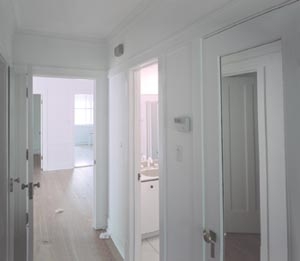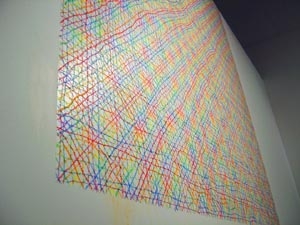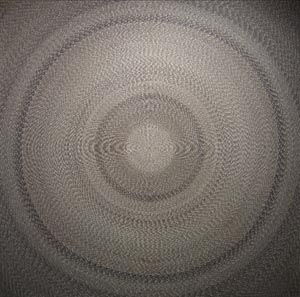Feature: Reviews
BROAD SHOULDERS
Reportage on art, artists, and events in Chicago
Somewhere/Somewhere
Laura Litensky
April 28-May 29
Remember the times you have been hunting for the perfect apartment? A place that has enough character to invite visions of your own complicated life between the empty walls and floor? Laura Litensky presents us with photographs of such vacant and waiting places where the slightest bit of architectural character, an old door, crown molding, has been white washed to increase marketability. Her exhibition of large format color prints shown at moniquemeloche gallery, aptly titled Somewhere/Somewhere shows us the residue of the transitory populations that inhabit ‘reclaimed’ urban areas. These pictures make beautiful the sad neutrality of contemporary real estate—neutrality here associated with and rescued by minimalist aesthetics.
In every photograph a small object holds forth the promise of individuality, but on closer examination it is an abandoned power strip or scraps of electrician’s tape—objects as neutral as the off-white paint or beige carpet so relentlessly offered for our view. These photos embody a home depot utilitarianism that is both attractive and repulsive while evoking the personal through its very absence. Scrupulously avoiding sentimentality, Litensky manages to record the almost magical tension particular to moments of transition.
moniquemeloche gallery
118 N. Peoria
Chicago, IL 60607
www.moniquemeloche.com
Xylor Jane: Say when.
Michelle Grabner: Project Room
April 29-May 28, 2005
Is it possible to resuscitate the 20th century obsession with the grid? Is it desirable? In the case of Xylor Jane’s paintings and drawings at Wendy Cooper gallery the answer is yes. While early grid paintings celebrated a kind of limitless expansion, these drawings make use of the constraints imposed by measurement. In a way, her paintings have nothing to do with grids, modernism, or minimalism (just as bondage has nothing to do with ropes) but with the desire for limits, containment, and the ecstatic moments such restraints can produce. There are many moments of ecstasy in this show of small intense marks and bits of writing generated by mathematical and scientific formulas. The marks the artist makes do not challenge the territory they delineate, nor would the territory exist without the marks that define them. There is no struggle here, no token acts of resistance, but a pleasurable ritual of exchange. The result is that each drawing creates it’s own vibration. It’s as if the wholehearted use of convention short circuits it’s own nature by insistence. The resulting group of drawings/paintings is surprisingly fresh, just as the sensations created by B&D (ed.-bondage and discipline) can feel new each time precisely because of their familiar rituals. [See more of Jane’s work in Bay Area Now 4 at Yerba Buena Center for the Arts.
Her drawings are paired with paintings by Michelle Grabner. At first their work seems similar—and one can sense a common ground (a celebration of 20th century modernism in all its glory for one!), but as one moves between the two bodies of work the differences between them reverberate. The two exhibits are positioned in a didactic relationship: grid/spiral, light/dark, external/internal. Jane’s paintings refer to complex formulas that are held in check by their own systems while Grabner’s simple and direct paintings feel like a force of nature. In Grabner’s work there is no codex necessary, the artist finds a generating point and proceeds to mark her territory with a series of dots expanding into spirals. Following the tradition of the aboriginal painters of Australia each dot is both a whole world onto itself and one part among many. Almost geological forces such as evaporation and pressure determine the visual effects of the paintings. Her form and technique is so transparent one is drawn into the optical sensation of the paintings immediately. With simple and direct means Grabner has managed to make us dizzy with the rhythm of expansion and contraction.
Wendy Cooper Gallery
119 Peoria #2D
Chicago, IL 60607
www.wendycoopergallery.com
Industry of the Ordinary
Upon arriving in Chicago my email became immediately flooded with mysterious invitations to attend events created by something called “Industry of the Ordinary”. I went to the website indicated and found an equally mysterious and elegant site that included directions to an event called Match of the Day 2, despite the freezing cold, windy day filled with hail and rain—and I mean UNBELIEVEABLE TORRENTS, I searched for the beachfront indicated by my invitation. Along the edge of Lake Michigan, which might as well have been along edge of the earth, were two wigged and robed figures on a levee playing table football, known in the U.S. as foosball, amidst furiously crashing waves. They struggled heroically against wind, rain and tide in Old Testament costumes, looking like Sunday school illustrations of Moses or Christ or Roman gods, while they tried to play to play a decent game of table football. Clearly the stakes of this game were high, after all the names of the two players were Old God and Young God. I wonder just what the winner received? A chance to produce an earthquake that would test the patience of Job or the right to end the storm by turning the rain into falling frogs? Perhaps the stakes were as topical as ending the deployment of troops in Iraq. Only god (or the gods) knows for sure.
After this revelatory experience, I found myself looking eagerly for new messages from Industry of the Ordinary. I would scan my inbox daily and finally I took the virtual leap and went to their Website to email a few simple questions.
Industry of the Ordinary is Adam Brooks and Mathew Wilson, (both artists and faculty at Columbia College, Chicago) along with a number of collaborators on a revolving basis.
BS: How did Industry evolve?
AB/MW: Dropping 163 lbs was our first project together, before we even had the name for our collaboration. We knew that we wanted to produce a piece together, and it developed from that point onwards. We also share a sense of indignation about many aspects of the world that we wanted to turn into something constructive.
BS: What is the mission of Industry?
AB/MW: Industry of the Ordinary is dedicated to an exploration and celebration of the customary, the everyday, and the usual. Their emphasis is on challenging pejorative notions of the ordinary and, in doing so, moving beyond the quotidian.
BS: It seems that documentation and Internet communication plays a large role in the productions of Industry of the Ordinary.
AB/MW: We often work with photographers and videographers in the tradition of performance art practice. The resultant image functions primarily to verify and authenticate the concept of the work, but this relationship between the live act and its document has always been problematic. The photograph attempts primarily to preserve the lived experience of those that witness the piece, in the knowledge that this is an impossibility. With this in mind, other visual and textual artifacts are often included in the presentation of their work, and the website, http://www.industryoftheordinary.com, serves to amplify the photographic image and make Industry part of an expansive network.
BS: What next?
AB/MW: Projects by proxy and a project for Millennium Park. We’ll keep you posted.
Industry of the Ordinary has produced an original work for Stretcher. To view and participate, log on to www.industryoftheordinary.com
This year Chicago art aficionados had their pick of art fairs—three of them were held simultaneously from April 29-May 2. The Chicago Contemporary and Classic at Navy Pier’s Festival Hall, the 12-year-old Art Chicago which was mounted in a huge white tent and renamed Art in the Park on Butler Field and the NOVA Young Art Fair produced by Michael Workman. An art critic for New City magazine, Workman is also the publisher of Chicago’s newest art publication, Bridge Magazine, and is dedicated to providing opportunities for artist collectives and artist run spaces as well as traditional galleries. The NOVA fair took place in a freezing cold parking garage in the West Loop gallery district and hosted site - specific installations in bathrooms and wrecked rooms. Such installations were complemented by the few brave commercial galleries who pledged themselves to this unconventional venue while huddling around space heaters in large, unfashionable parkas. See BROAD SHOULDERS correspondent Andrea Reyes views on the Nova Young Art Fair in BS2.
NEXT INSTALLMENT—INDUSTRY OF THE ORDINARY updates plus the activities of the recently established Chicago New Media Group, former gallerist Paul Klein’s Museum Project and more.



